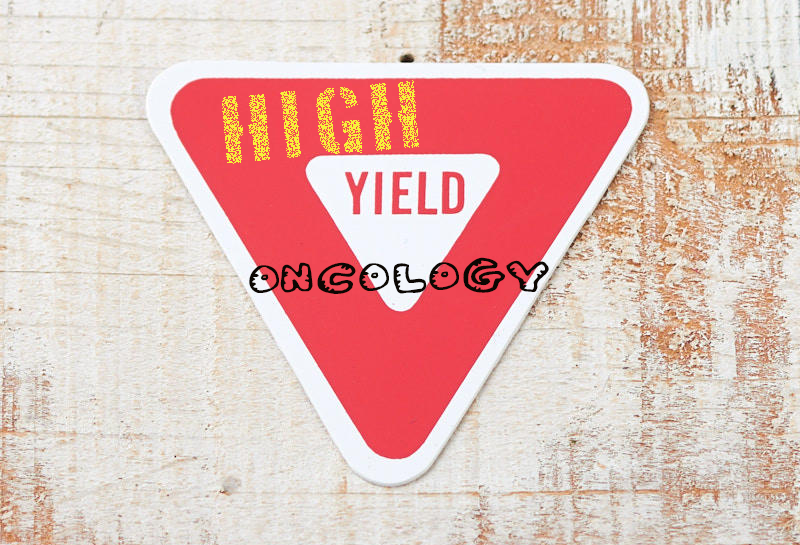Now, That’s What I Call High-Yield: Oncology
- by
- Jan 11, 2022
- Reviewed by: Amy Rontal, MD

If any subject needed the high-yield teased out of it, oncology would be the one. We go through medical school under the repeated mantra that, “You don’t need to know chemotherapy regimens,” and this leaves us wondering…”Well, what do I need to know then?”
At the very foundation, realize that neoplasms are an abnormal, unchecked proliferation of a particular cell line. Sometimes the cell is a normal resident of a tissue that’s just decided to proliferate for no good reason, but at the same pace as the surrounding tissue (hamartoma). Other times, it’s of a blood cell lineage, and leads to leukemia. Glandular tissue can become cancerous and form adenocarcinoma. These cancerous cells usually have the capacity to travel to distant sites in the body, whether lymphatically or hematogenously, and seed in totally separate body tissues causing metastases.
Leukemia & Lymphoma (10) – Understanding the difference between these two pathologies can be as difficult as placing an IV in a screaming child. The lines are blurry, and like Robin Thicke, we hate those blurred lines. To keep it simple, think of lymphoma as a tumor of a lymph node. Leukemia (leuk = white, -emia = in the blood) is an overproliferation of white blood cells from either lineage (myeloid or lymphoid), with these cancerous cells found in the serum. They get produced in the same place that normal WBCs get produced – in the bone marrow.
Lymphomas come from lymphoid cells (B and T cells), and taxonomy splits into two forms: Hodgkin’s lymphoma (a singular disease process) and non-Hodgkin’s lymphoma (all of the other types of lymphoma). Hodgkin’s is hallmarked by Reed-Sternberg cells (owl eyes!) with CD15+ and CD30+ cell surface markers.
Non-Hodgkin’s types include Burkitt’s lymphoma, diffuse large B-cell lymphoma, CNS lymphoma, mantle cell lymphoma, and follicular lymphoma. If possible, definitely know your chromosomal translocations, as they can net you easy points if you know which ones associate with which disease. The aforementioned are all B-cell diseases; two further types of NHL, T-cell lymphoma and Mycosis fungoides, are forms of lymphoma that spawn from the T-cell line.
Multiple Myeloma (9) – This disease process is such a great teaching model, you can certainly expect to see it on Step 1. First, understand the pathology here. Some plasma cell (a former B-cell whose new job is to pump out a singular clone of a particular antibody) runs amok, making countless copies of itself, generating innumerable copies of its particular antibody. Unlike a normal healthy immune system which produces nice even numbers of a wide array of antibodies, in multiple myeloma, only one antibody is produced in ridiculously high amounts. What does this do to the patient? Think CRAB symptoms. HyperCalcemia (from bone breakdown), Renal failure (lots of proteins clogging up glomeruli), Anemia (as the bone marrow is crowded out and focused only on aberrant production of one antibody instead of RBCs), and Bone lesions (as tumor factors favor osteoclasts over osteoblasts). In the urine, we find Bence-Jones proteins, the light chains of the overproduced immunoglobulin.
Cancer Drugs & their Toxicities (8.5) – To internalize the mechanism, targets, and side effects of all of the drugs used to fight cancer is far beyond the scope of Step 1. Some drugs are much more high-yield than others. Methotrexate makes a fantastic biochemical teaching model via its dihydrofolate reductase inhibition, impeding DNA synthesis. Paclitaxel and vinca alkaloids prevent microtube action, thereby arresting the cell cycle. When it comes to platinum agents (cisplatin, carboplatin), just think of a pretty platinum cross-linked chain — these drugs serve to cross link DNA.
As far as monoclonal antibodies, it seems that new ones enter practice every few months. The appreciable ones here are imatinib, the prototypical tyrosine kinase inhibitor used for CML. Rituximab is a CD20 antibody, attaching to B-cells and marking them for destruction. Trastuzumab is another tyrosine kinase inhibitor used for HER-2 positive breast cancer.
Probably more important than mechanism of these esoteric drugs are their toxicities. Outside on oncology, you likely won’t be prescribing therapeutic agents, but no matter your chosen field of medicine, you will likely encounter patients on these drugs. Knowing their side effects is highly testable.
For an all-in-one graphic on the toxicities you should know about, a google search for “chemo man side effects” will find you pictures from the high-level to ultra-detailed. The figure in First Aid should get you what you need to know. Of the utmost importance, remember the following:
Vincristine → peripheral neuropathy
Bleomycin → pulmonary fibrosis
Doxorubicin → cardiomyopathy
Cyclophosphamide → hemorrhagic cystitis
As a general reminder, all of the drugs that interfere with DNA synthesis and cell-cycle progression don’t just affect cancerous cells. While neoplasms are more sought after targets because of their incredibly rapid turnover, other cells in the body with rapid turnover (mucosal surfaces, skin, bone marrow) get affected, too. This leads to mucositis, immunosuppression, and anemia.
Like everything we cover, that was a lot of information! Keep approaching each section in a systematic way, deciding how deep to delve into based on your test goals. No one is meant to memorize the mechanism, use, and side effects of all of these drugs. Do what you can, and keep answering questions via practice tests and UWorld to hone in on the level of knowledge necessary to score correct answers.
Want to learn more about high yield leukemias and lymphomas for the USMLE & COMLEX? Check out this video from Dr. H. Moses Murdock and Dr. Joe Hanson.









